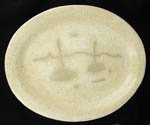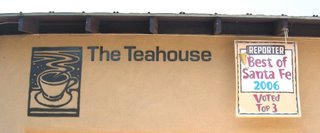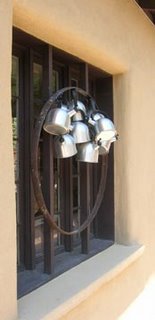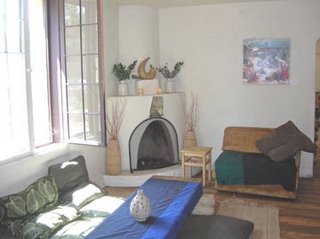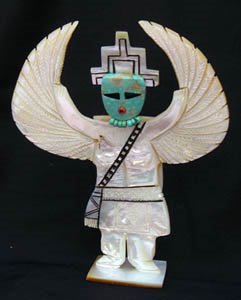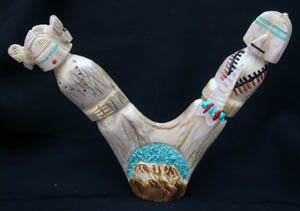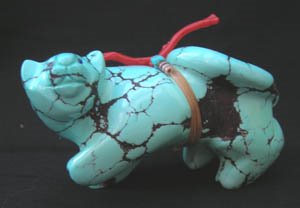Let’s pick up from there.
This restaurant aptly epitomizes the split personality that is “The City Different” as Santa Feans like to call it. The split consist of the moneyed elite that reside in the cinco-mille-square-foot haciendas near the Santa Fe Opera. You can spot them on the street by their Southwest-chic attire with silver bolos on the men and diamonds on the women. This is not a put-down. This group is largely responsible for the philanthropy that supports cultural life in
 We have always enjoyed the loose ambience of the La Cantina, and its adventurous authentic Mexican ‘comida.’ The menu here includes antijitos such as “Santa Fe Favorite” BBQ Duck Quesadilla, a Susanne favorite as well. This time, however, she chose the Cuatro Tostadas; individual chicken, shrimp, beef and vegetable tostadas with tomatillo avocado, tequila habenero and chile arbol salsa.
We have always enjoyed the loose ambience of the La Cantina, and its adventurous authentic Mexican ‘comida.’ The menu here includes antijitos such as “Santa Fe Favorite” BBQ Duck Quesadilla, a Susanne favorite as well. This time, however, she chose the Cuatro Tostadas; individual chicken, shrimp, beef and vegetable tostadas with tomatillo avocado, tequila habenero and chile arbol salsa.

Located away from the plaza area, Maria’s is known primarily to resident Santa Feans.
 Maria's unobtrusive street frontis well-known to regular residents of Santa Fe.
Maria's unobtrusive street frontis well-known to regular residents of Santa Fe.
It also is known primarily for its margaritas. More than 100 are offered, ranging from a special Maria’s margarita made from Cuervo Gold tequila, Bols triple sec and fresh squeezed lemon juice, which will set you back about five bucks, to the 24-Karat Gold Reserva, featuring 100th Anniversary Hand Crafted Jose Cuervo 100% agave anejo barrel select Reserva de la Familia tequila and 150th Anniversary Cuvee speciale Cent-cinquantenaire Grand Marnier with fresh squeezed lemon juice. Set aside $40 for this one.
Maria’s margaritas have been voted the Best in
Tequila is made only in
Incidentally, the Mexican government strictly regulates tequila producers and issues a NORMA number to those distillers that meet the standards. The N-O-M designation followed by four numerals indicates real tequila. Without that code, it simply is not real tequila.
The second liquor is triple-sec, a Cointreau brand liqeur distilled from the sun-dried skins of exotic oranges grown in the
Some of Maria’s margaritas are made with Grand Marnier, a liqeur similar to triple sec that has been fortified with premium cognac and aged for 18 months. While lime juice is the traditional juice to be added, Maria’s uses freshly squeezed lemon juice because the juice is more consistent.
Finally, Maria’s margaritas are shaken with ice so that the ice chips off to dilute the mixed drink just enough. Blenders are not used because they produce too much chipped ice and water down the final flavor.
Maria’s recommends against shots or slammers of tequila. You miss the flavor nuances and intoxication can come quite quickly. Helpfully, on the latter point, Maria’s warns flat-landers that drinking alcohol in the higher, 6,000 foot altitude of
As for eats to accompany the drinks, try Maria’s famous barbecue ribs, billed as a  Don’t pass on the flan for dessert, by the way. It was one of the best we have had anywhere.
Don’t pass on the flan for dessert, by the way. It was one of the best we have had anywhere.
Let’s finish with breakfast, Tecolote’s specialty. Owner Bill Jennison actually states on the menu cover, “Great Breakfast – No Toast”.
Tecolote’s premises are located on
In addition to the traditional eggs-and-home-fries breakfast items, Tecolote offers Northern New Mexican breakfasts such as huevos rancheros, huevos Yucatecos, carne y huevos and breakfast burritos. Each is served with a bountiful bakery basket or tortillas.
One of the attractive aspects of Tecolote, however, is its homey, family ambiance, characterized by the patronage of locals. The local community involvement of Tecolote is demonstrated as you enter the front door. Tecolate means “owl” in the Nahuatl (Aztec Indian) language. Pictures of owls, usually drawn by youngsters who accompany their parents and grandparents to a Tecolote breakfast, adorn places of honor on the restaurant walls. These artistic expressions are encouraged by the Tecolote staff.
Tecolote manager, Chris, stands proudly by the owl works by junior artists.
Although owners, Bill and Alice Jennison named the restaurant in 1980 after an all-but-deserted, near-by town, they are pleased that the owl is such a celebrated critter in so many cultures. You’ll be wise to schedule at least one home-spun breakfast at the Tecolote. When you do, you’ll find Bill in back, baking up delicious muffins and biscuits to fill those bakery baskets. If you are like us, you will ask your server to put the uneaten bakery items in a box to take home with you. They will oblige with a smile.
~~~~~~~~~~~~~~~~~~~~~~
Tribal Artery is the blog about tribal art offered periodically by Aboriginals: Art of the First Person and its allied web sites at Native-JewelryLink, with gorgeous, genuine American Indian necklaces, bracelets, pendants, pins and earrings; ZuniLink, for hundreds of authentic Native American fetish carvings by Zuni , Cochiti, Navajo and San Felipe artists; Tribal Works, offering a wide selection of tribal art from Africa, Aboriginal Australia, the Arctic and Native America, including Navajo folk art, and Native-PotteryLink, home to the finest in contemporary and historic Native American hand-created pottery, storytellers and nativity sets.


